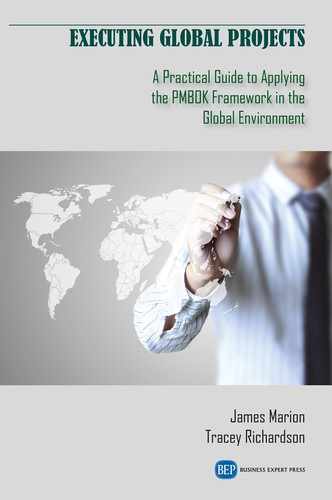Building Global Project Capability
The result of global project assessment will indicate possible areas for improvement. Knowing which global factors that are not adequately addressed in global project plan is a good beginning. However, the next question is “Where does the global project team go from here?” Recalling the sit, stand, walk, run, train model of process maturity, the first step is to have a process. The process itself may not be ideal, but at a minimum, it is identified and documented. An approach for beginning this effort is to hold a workshop with select project team members as well as select management stakeholders from the sponsoring organization. The workshop would carry out the following activities:
- Review global project assessment data: All collected data including survey results, interviews, and examination of documents is reviewed with the workshop attendees and discussed.
- Brainstorming/process identification: The results of the evaluation of the collected data provides evidence of missing policies, procedures, and processes for planning and executing global projects along with the specific global factors that are unsupported or weakly supported. The workshop attendees use this data to brainstorm and compile a list of missing processes.
- Chartering process improvement projects: The identified “missing pieces” of global project management are then used to charter project teams to develop a corresponding process. Given that process effectiveness is the outcome of maturity, it is acknowledged that strong processes take time to implement and fully develop. Because of this, a recommended beginning is to charter each process improvement team to develop a template document for project teams to employ as a beginning for establishing an initial process (Figure 15.1).

Figure 15.1 Global project capability process improvement
Standing, Walking, Running, and Training
Once a process is in place in the form of a plan document template, the next step in the maturity model is using the template each time a project is chartered, awareness of the template among multiple project teams, and further the continuous improvement of the process as reflected by the initial template. It is recommended that the process improvement teams that produce the first process template deliverables are used to assess the degree of usage of the templates over time and evaluate the awareness of the process among all global project teams. Further follow-up workshops can be held by the same global project assessment and readiness preparation group for evaluating data on the usage of the new processes, discuss what is working and what is not working, and then identify potential for improvement of each of the process linked to global project factors. Future workshops could follow the very same pattern as the initial workshop that led to the chartering of project teams. For example, a quarterly or semiannual review of the global project process improvement effort begins with analyzing data on the usage of the process templates including how effective they were. Such reviews also identify areas in which they might be incomplete. Also, each review may collect further data on the level of awareness of processes. It is also of interest in a workshop such as this to consider the degree to which teams may be deviating from the template or modifying it in any way. Once this discussion is taking place, they can be brainstorming among the workshop process improvement teams on what should be improved in the global project plan process templates so that lessons learned from their usage in the existing and previous projects can be incorporated in future projects. The identified improvements can then be used to charter project teams in the same manner as was done initially. The deliverables will be modifications to existing processes or process templates or in some cases complete revisions of previously proposed project plan process templates. After two or three iterations of the process, review is envisioned that the sit, stand, walk, run, train model of process improvement will have reached the “train” status. At this point, the processes could be expected reasonably expected to be fully established and how the global project team does business and the evaluation of global project processes could be folded in two project reviews and be part of the organizational process assets as defined by the PMBOK. Stated in other words, these are documents, templates, policies, procedures, and plans that every project uses. Finally, instead of having a separate set of team members to create implement and assess global project processes, eventually this oversight activity could transition to the project office or other executive governance body within the sponsoring organization (Figure 15.2).

Figure 15.2 Global project capability governance
An outcome of this global project process improvement would be that periodic assessments and forms in the form of data collection from the readiness survey interviews and document studies should produce consistently high compliance scores. In such an environment, global projects would likely experience lower risk and be executed far more efficiently.
Every Project Is Global
There is a strong argument to be made that all projects are global. The vast interconnectedness of the information age in which projects operate today virtually guarantee that at least some global factors will be involved in the project from the conception of the project to its delivery. Project managers today will benefit from this perspective as it will likely lead them to take steps to develop and mature global project management competence in their project management practice. There is no end to the learning and development given the shifting of global alliances and national boundaries, changes in the macroenvironment, and finally the ongoing enhancement of technologies that support global management. Therefore, it is important to seek to incorporate global know-how, incorporate process discipline, and refine and optimize global project practices over time. Such ongoing development is a journey rather than a destination, and the global project scorecard and assessment tools will aid in providing the roadmap.
